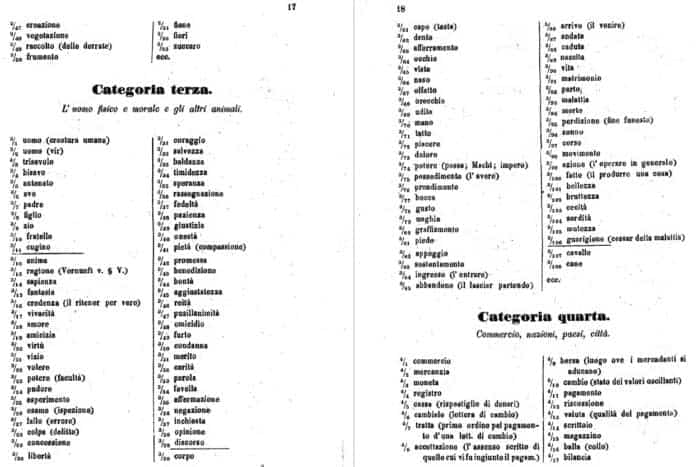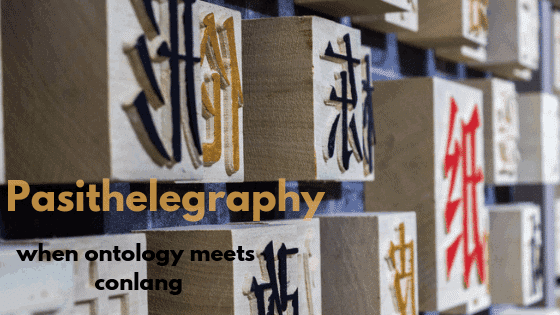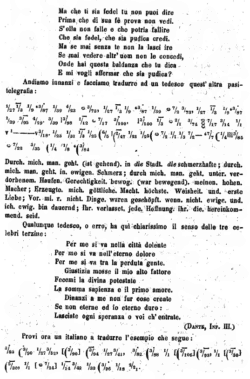
We have already met conlangs some months ago on the occasion of a Video-Fix about Ithkuil, one of the most complex and intriguing constructed languages on the scene. Ontology has been also mentioned plenty of times, for instance when speaking about its still relevant role in Knowledge Architecture in this article.
Pasitelegraphy is how Graziadio Isaia Ascoli called a project of “universal telegraphic language”, developed and published by himself in 1851.
The young scholar (at the time just 22 years old) was encouraged to publish his reflections on the subject because in July of the same year he discovered that a telegraph inspector from Vienna (“Mr. Rad”) was also working on a similar project. The author’s enthusiasm and haste to be the first to publish such a study are evident in the introduction to the work.
Recently, a friend of mine has informed me that word has spread that the telegraph inspector Mr. Rad of Vienna has submitted a project for a universal telegraphic language to the ministry.
Since it is a matter of a temporary independent discovery, I hasten to warn that the person who sent me this news, on the 13th of this month, has been by me informed of a telegraphic plan for a universal language. On the 14th of July, I pleaded the Circular Regency of Gorizia to issue an order for the telegrapher from here, so that he may provide me with any clarification I may need, in order to judge the possibility of putting into practice my new telegraphic transcription.
Mr. Rad’s project is, however, an arcane one. Now, although the idea of the universal telegraphic language in me was born only a week ago, I also undertake to begin in publishing, within ten days at the latest, the printing of a script that includes all my project, its genesis, and some examples of my pasithelegraphy.
The principle of pasitelegraphy is to transpose concepts into a standardized code, abstracting them from the phonetic and graphic signs through which they are expressed by individual languages.
By removing everything that could be peculiar to a language regarding its inflections and derivations and by rendering relationships and modifications of ideas in a pure way, the pasithelegraphy would allow those who receive the dispatch to know clearly the will of those who wrote, and of course to translate it appropriately, according to their own idiom.
Pasithelegraphy therefore tries to express all possible meanings in the most concise and complete way.
To achieve this, Ascoli adopts a predominantly numerical code.

To begin with, he divides the concepts that could be expressed into eight large categories, numbered from 1 to 8:
Clues of person;
relationship and mode of speech;
conjunctions of motion, time and place;
Religion, universe, the earth;
Physical and moral man and other animals;
Trades, nations, countries, cities;
Diplomacy, chancellery, war, jurisdiction;
Sciences, arts, crafts, their products and instruments;
Time place and quality;
The most common and important names;
[expander_maker id=”4″ more=”Click here to read more about Pasitelegraphy’s implementation” less=”Read less” ]
Within each category, then, each concept would have its own numbering, and each concept would then be represented by two numbers (“pasitelegraphic numerator” and “pasitelegraphic digit”), separated by a slash.
For example, in Category One:
1/1 continues joining (and)
1/2 junction alternating (or)
1/3 who speaks (me)
1/4 what you are talking about (you)
(…)
1/12 Appropriate to what is being said (mine)
1/13 Appropriate to what he talks to (yours)etc.
In the Second Category (Religion, universe, earth):
2/1 God
2/2 angel
2/3 religion (everything that refers to the link between man and divinity)
2/4 faith (religious belief)
…
2/16 universe
2/17 world
2/18 land (mainland)
2/19 sky
2/20 earth
2/21 powder
and so on.Here is how a in practice a pasithelegrafic text looks like. The rendered excerpt comes from Dante’ s Comedy inscription at the entrance to hell:
[/expander_maker]
At this point in my opinion it is worthy to make a digression in China.
As it is widely known, Chinese words are ideograms made up by strokes. Since a vocabulary cannot be sorted alphabetically, the question came spontaneously to my mind: how do they organize knowledge, and, in general, collections of words that must be ready to be retrieved?
This question led me immediately to the history of movable type in China, which I discovered had been used and experimented by Bi Sheng already in the 11th century.

Afterwards Wang Zhen improved the earlier experimented process by adding the methods of specific type cutting and finishing, making the type case and revolving table that made the process more efficient.
In Wang Zhen’s system, all the Chinese writing characters were organized by five different tones and according to rhyming, using a standard official book of Chinese rhymes. Two revolving tables were actually used in the process; one table that had official types from the book of rhymes, and the other which contained the most frequently used Chinese writing characters for quick selection. To make the entire process more efficient, each Chinese character was assigned a different number, so that when a number was called, that writing character would be selected. Rare and unusual characters that were not prescribed a number were simply crafted on the spot by wood-cutters when needed.
Wang Zhen’s wooden movable type was used to print the local gazetteer paper of Jingde City, which incorporated the use of 60,000 written characters organized on revolving tables. During the year of 1298, roughly one hundred copies of this were printed by wooden movable type in a month’s time.
In conclusion, pasithelegraphy and Chinese lexicography have not shown to have much in common, except the degree of arbitrariness characterizing the choice of term’s organization criteria and their efficacy for the practical use they were conceived and designed for.
What is certain, is mankind’s afflatus to reduce and organize the vast complexity of the universe.
References
Pasitelegrafia, Wikipedia, Accessed date [08.09.2019];
Graziadio Isaia Ascoli, La Pasitelegrafia, Accessed date [08.09.2019];
Movable type, Wikipedia, Accessed date [08.09.2019];
Invention of Wooden Movable Type in China, HistoryofInformation.com, Accessed date [08.09.2019].
Wang Zehn, Wikipedia, Accessed date [08.09.2019]
History of printing in East Asia, Wikipedia, Accessed date [08.09.2019]
 Introduced, translated and rearranged by Cosimo Palma
Introduced, translated and rearranged by Cosimo Palma
I studied philosophy, historical philosophy, philosophical history and history in the redundant Naples, computational linguistics and informatics in the city of Marx.
Language enthusiast and chess player in the free time, until the end of September I will spend my busy time in the Tower A of the European Parliament in Luxembourg, trying to do my best in the communication as well as in the IT department of the Terminology unit.



